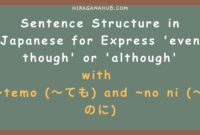Learn How to Describe Your Skills to Other in Japanese: Smart or Not Smart in
Something
Understanding how to express whether someone is skillful or not in a
particular area is essential when learning the Japanese language. This lesson
will introduce you to the key grammar patterns and provide practical examples
to help you communicate effectively about skills and abilities.
Basic Sentence Structure
The grammar pattern we will focus on is:
Noun 1 + は (wa) + Noun 2 + が (ga) + 上手 (jōzu) / 下手 (heta) + です
(desu)
This structure allows you to say things like “She is good at singing” or “He
is bad at driving.”

Example Sentences with な Adjectives
Here are three example sentences using な adjectives
上手 (jōzu) and 下手 (heta):
-
かれはりょうりがじょうずです
(kare wa ryouri ga jouzu desu): He is good at cooking. -
かのじょはえがへたです
(kanojo wa e ga heta desu): She is bad at drawing. -
わたしはぴあのがじょうずです
(watashi wa piano ga jouzu desu): I am good at playing the piano.
Example Sentences with い Adjectives
While 上手 (jōzu) and 下手 (heta) are
na-adjectives commonly used to describe skillfulness, here are three sentences
incorporating い adjectives to express related qualities:
-
かれははやくはしれます
(Kare wa hayaku hashiremasu): He can run fast. -
かのじょはかしこいです
(Kanojo wa kashikoi desu): She is smart. -
わたしははやいです
(Watashi wa hayai desu): I am fast.
Note: While 上手 (jōzu) and
下手 (heta) specifically describe skill levels in activities,
い adjectives like 速い (hayai) and
賢い (kashikoi) describe general qualities. They can
complement the main grammar pattern but serve slightly different functions.
Vocabulary List
To enhance your understanding, here is a list of vocabulary used in the
example sentences above:
な Adjectives
| Kanji | Hiragana | Romaji | Meaning |
|---|---|---|---|
| 上手 | じょうず | jōzu | good at |
| 下手 | へた | heta | bad at |
い Adjectives
| Kanji | Hiragana | Romaji | Meaning |
|---|---|---|---|
| 速い | はやい | hayai | fast |
| 賢い | かしこい | kashikoi | smart |
Additional Vocabulary
| Kanji | Hiragana | Romaji | Meaning |
|---|---|---|---|
| 彼 | かれ | kare | he/him |
| 彼女 | かのじょ | kanojo | she/her |
| 料理 | りょうり | ryouri | cooking |
| 絵 | え | e | drawing/painting |
| ピアノ | ぴあの | piano | piano |
| 走れます | はしれます | hashiremasu | can run |
Tips for Learning to Describe Skillfulness
-
Expand Your Vocabulary: The more words you know related
to skills and qualities, the easier it will be to describe abilities.
Utilize free language learning resources and apps to build your
vocabulary. -
Practice Regularly: Consistent practice helps reinforce
grammar patterns and vocabulary retention. Try writing your own sentences
or speaking them aloud to improve fluency. -
Engage with Native Speakers: Joining virtual classes or
language exchange programs can provide practical experience in using these
expressions naturally.
Applying What You’ve Learned
To effectively use the grammar pattern
Noun 1 + は + Noun 2 + が + 上手 / 下手 + です, try creating
your own sentences. For example:
-
ともだちはサッカーがじょうずです
– (Tomodachi wa sakkā ga jōzu desu): My friend is good at soccer. -
おとうとはダンスがへたです – (Otōto wa dansu ga heta desu): My younger brother is bad at
dancing. -
はははガーデニングがじょうずです
– (Haha wa gādeningu ga jōzu desu): My mother is good at gardening.
Common Mistakes to Avoid
-
Incorrect Particle Usage: Ensure you use
が (ga) after the second noun, not
は (wa). -
Adjective Agreement: Remember to match the form of
上手 (jōzu) and
下手 (heta) appropriately within the sentence. -
Word Order: Maintain the correct order:
Noun 1 + は + Noun 2 + が + 上手 / 下手 + です.
Additional Resources
-
Free Online Courses: Many platforms offer free Japanese
lessons that cover expressing skills and abilities. Websites like Duolingo
and Memrise provide interactive lessons to reinforce your learning. -
Language Learning Apps: Utilize apps to practice
vocabulary and grammar on the go. They often include exercises that make
learning engaging and effective. -
Virtual Classes: Joining an online class can offer
structured learning and opportunities to practice with instructors and
peers.
Describing whether someone is skillful or not in Japanese using the pattern
Noun 1 + は + Noun 2 + が + 上手 / 下手 + です is an
essential skill for everyday conversations. By practicing the provided
examples and expanding your vocabulary, you’ll be able to express abilities
clearly and confidently. Remember to utilize free resources and maintain
consistent practice to enhance your language learning journey.
Happy learning, and enjoy your path to mastering the Japanese language!


